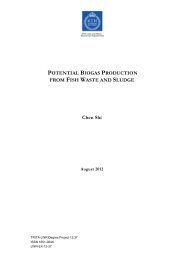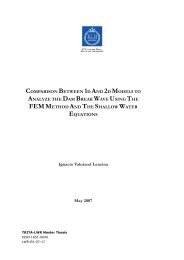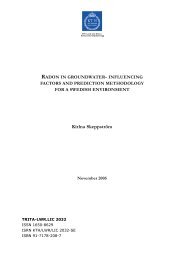water sources, infrastructure, space and the dynamics of ...
water sources, infrastructure, space and the dynamics of ...
water sources, infrastructure, space and the dynamics of ...
You also want an ePaper? Increase the reach of your titles
YUMPU automatically turns print PDFs into web optimized ePapers that Google loves.
Water <strong>sources</strong>, <strong>infrastructure</strong>, <strong>space</strong> <strong>and</strong> <strong>the</strong> <strong>dynamics</strong> <strong>of</strong> environmental diseases in Saboba District: Using GISerosion leading to <strong>the</strong> formation <strong>of</strong> gullies. The area consists <strong>of</strong> mainlygrassl<strong>and</strong>, interspersed with guinea savannah woodl<strong>and</strong> characterised bydrought resistant trees like baobab, sheanut, acacia <strong>and</strong> neem.Population <strong>of</strong> <strong>the</strong> areaAccording to Ghana Statistical Service, GSS, (2005a) <strong>the</strong> population <strong>of</strong><strong>the</strong> former Saboba-Chereponi District in 2000 was 93,847 with 47,051(50.1%) being females <strong>and</strong> 46,796 (49.9%) males. The population wasestimated to be 113,087 in 2005, <strong>of</strong> which about half <strong>of</strong> it could be <strong>the</strong>population <strong>of</strong> Saboba district alone. The growth rate is estimated to be2.9% <strong>and</strong> sex ratio is 99.5. The population in <strong>the</strong> district have beenincreasing considerably due to high birth rate <strong>and</strong> reducing death rates.Ano<strong>the</strong>r factor is <strong>the</strong> return <strong>of</strong> Konkombas (indigenes) from <strong>the</strong> nearbydistricts after <strong>the</strong> 1994 ethnic conflict <strong>and</strong> <strong>the</strong> booming <strong>of</strong> tradingactivities. The 1994 ethnic conflict between Konkombas <strong>and</strong> Kombas onone h<strong>and</strong> <strong>and</strong> Dagombas, Nanumbas <strong>and</strong> Mamprusis on <strong>the</strong> o<strong>the</strong>rcaused many Konkombas to move to Saboba district where many <strong>of</strong><strong>the</strong>m consider as <strong>the</strong>ir “native” place. The movement <strong>of</strong> Konkombas toSaboba area is still occurring, but on a limited scale. The urbanpopulation is less than 20%. The population <strong>of</strong> <strong>the</strong> district is made up <strong>of</strong>mainly one ethnic group, Konkombas (indigenes), who form over 80%<strong>of</strong> <strong>the</strong> district’s population. O<strong>the</strong>r minor ethnic groups are <strong>the</strong> Moshies,Ewes, Basaris, Dagaatis <strong>and</strong> Akans. Varied religious bodies such asChristianity, Traditional African Religion <strong>and</strong> Islam exist.Economic Activities <strong>and</strong> Agricultural L<strong>and</strong> useMore than 80% <strong>of</strong> <strong>the</strong> population in <strong>the</strong> district is engaged in rain-fedsubsistent agriculture. Cultivable l<strong>and</strong> area is about 40% with extension<strong>of</strong>ficer/farmer ratio <strong>of</strong> 1:5,996 (District Planning Coordinating Unit,2002). There is only one farming season, which coincides with <strong>the</strong> rainsfrom April to October. The hoes <strong>and</strong> bullocks are <strong>the</strong> main methods <strong>of</strong>l<strong>and</strong> preparation. However, tractor ploughing is increasingly being used<strong>of</strong> late, due to <strong>the</strong> so-called mechanisation <strong>of</strong> agriculture. The people areengaged in both food <strong>and</strong> cash crop production such as rice, maize,millet, yam, cassava, cotton <strong>and</strong> cashew. The inhabitants also rear (freerange)animals like cattle, goats, sheep, pigs <strong>and</strong> poultry. Trading, foodprocessing, fishing, pottery <strong>and</strong> shea butter processing are <strong>the</strong>commercial <strong>and</strong> small-scale industrial activities undertaken in <strong>the</strong> district.Studies conducted by <strong>the</strong> District Assembly <strong>and</strong> Integrated DevelopmentCentre (2004) show that women are engaged in only <strong>the</strong> less skillintensiveactivities such as petty trading <strong>and</strong> pottery due to little/noeducational background <strong>and</strong> ownership <strong>of</strong> capital.Education, Transport <strong>and</strong> Social FacilitiesFormal education was first introduced to <strong>the</strong> inhabitants in 1944, <strong>and</strong> hassprung up subsequently after <strong>the</strong> introduction <strong>of</strong> <strong>the</strong> policy <strong>of</strong> FreeCompulsory Basic Education by <strong>the</strong> Convention People’s Party (CPP)Government in 1950/60s. There are currently one Senior High School,one Technical institute <strong>and</strong> several Junior High Schools, primaries <strong>and</strong>day-nurseries in <strong>the</strong> district. None <strong>of</strong> <strong>the</strong> roads within Saboba district ismotorable in all seasons. The roads are all paved <strong>and</strong> gravelled type, withfeatures <strong>of</strong> third class category. Also present are all categories <strong>of</strong>footpaths. Basic social amenities like health centres, pipe borne <strong>water</strong><strong>and</strong> electricity are also present.9
















